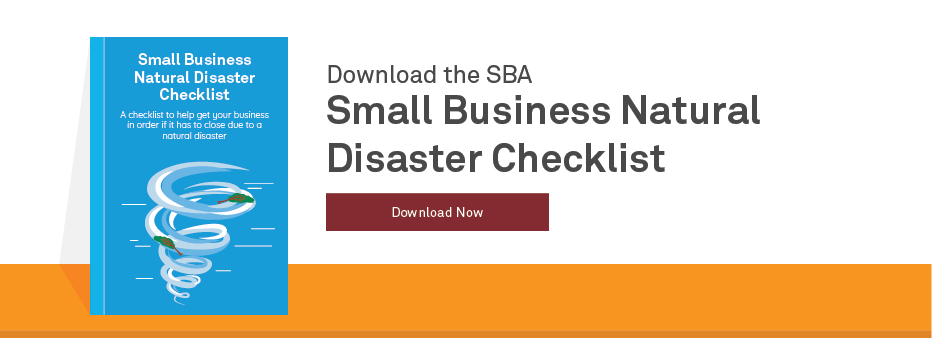Any small business can get turned upside down by an unexpected event whether it’s from COVID-19, a wildfire or a hurricane. But having a disaster plan in place can help get you back in business quickly.
In fact, lack of planning contributes to a surprising statistic: as many as 25% of small businesses never reopen following a major disaster, according to the Federal Emergency Management Agency (FEMA). This means that getting up and running again quickly is crucial for business survival.
Recent disasters that have impacted small businesses include:
- Hurricane Sandy hitting the East Coast
- Tropical Storm Karen hitting Puerto Rico
- A tornado in Joplin MO
- Wildfires in California
Even a small storm that causes a power outage can grind your business to a temporary halt. However, proper business insurance coverage and having crisis management strategies in place will help your business weather any storm.
The Small Business Administration and other organizations offer an array of resources that can help you create a small business disaster plan so your company can recover.

11 Steps to Create a Disaster Action Plan for Your Business
It’s important to create a written plan and update it yearly. To see how you can get started, read through 11 actions small business owners can take below:
Start with a checklist.
A business disaster checklist offers an overview of the components of a small business recovery plan. Keep it handy as you create your plan, and check off each completed action to make sure you don’t miss a crucial step. A checklist should include sections on communications, data, employees, operations and safety.
Prepare for risks.
Learn the specific types of hazards your business is likely to face and what to do during and immediately after these disasters. Review the Small Business Administration’s resource for disasters. This can be for:
- Earthquakes
- Hurricanes
- Tornados
- Wildfires
- Winter weather
On top of this, you should learn about the warning systems used in your community, and designate locations for you and your employees to seek shelter if necessary. To make sure you’re alerted promptly to any impending problem, you can buy a National Oceanic Atmospheric Administration (NOAA) Weather Radio with a tone alert feature. This will warn you 24 hours a day about natural disasters, other hazards like chemical or oil spills, and temporary 911 outages in your area.
Get help from disaster experts.
Sign up for the Red Cross Ready Rating program, which can provide business preparedness training to help you ensure that you are ready to face a weather catastrophe or other disaster. Experts may have recommendations to make your business safer, such as installing shutters to protect windows and inexpensive emergency lights that turn on during power outages. The Red Cross also recommends that you make sure your small business is properly protected by business insurance and that you check into business continuity insurance.
Create an emergency kit.
You, your employees and customers could get stuck in your business unexpectedly due to extreme weather or even a freak occurrence like a hazardous materials spill from a tipped truck. A small business should have an emergency kit containing enough non-perishable food, bottled water and other supplies to last multiple people for 72 hours. Your kit should include:
- A can opener
- Flashlights and extra batteries
- First-aid supplies
- A first-aid reference book
Designate a recovery team.
Choose a small group of employees who will take action in the immediate aftermath of an incident. Assign an employee to be a crisis manager and another to be their backup. You can then assign other employees to work on the recovery team. It’s important to meet with these employees to clearly outline their roles and responsibilities.
Consider communications.
Develop a crisis communications plan for your business. Create an employee communication tree, provide copies to employees and store an extra copy outside your business. Offer multiple modes of communication, including email, phone calls and texting, and consider keeping battery operated walkie-talkies as backup. Gather emergency numbers, including your small business insurance company, electrician, plumber, customer list and media contacts, and store that information offsite. Also set up programmable call forwarding for your business phones in case a disaster prevents you from reaching the office. This way, you can remotely forward calls to another phone.
ID critical business functions.
Every business is different, so it’s important to identify the critical functions of your business. Assign each business function a priority: high, medium and low. Decide how much downtime is acceptable for each function. For example, a critical business function of a custom packaging company would be fulfilling orders for boxes. A critical business function for a small credit union would be opening new checking accounts for customers.
Plan to protect your data.
Your small business relies on data, so you need a data backup and disaster recovery system, also known as a BDR, in place. This will protect you not only in a natural disaster or fire but also if you fall victim to a cyber attack. A BDR ensures that a catastrophe doesn’t wipe out your data, and it helps to minimize downtime caused by data issues. To set up a BDR, look for a service provider that has a solid reputation, 24-hour support and the ability to grow with your business, tech consultant Larry Alton recommends on Entrepreneur.com. Make sure your tax and financial records are stored safely.
Document your equipment.
Just like at home, it’s crucial to make a detailed list with photos or a video recording of the contents of your business, especially computers and other valuable equipment. This record will help facilitate the insurance claims process. Store this record safely so you can access it from outside your business.
Get ready for recovery.
What help will be available to your business in the wake of disaster? If you’re properly covered by business insurance, your insurer can play a huge part in helping you get your business back in gear. However, if you need a little extra help, you can apply for a business physical disaster loan from the federal government. These loans of up to $2 million, available to eligible businesses in a declared disaster area, may help you fix or replace items crucial to your small business, including equipment, machinery and inventory.
Make sure all systems go.
Regularly review your small business disaster plan, make sure all information is up to date and conduct testing to ensure all backup systems function as planned. Hold regular training sessions so all employees know exactly what to do if disaster strikes.
In light of COVID-19, it’s also a good idea to update your disaster preparedness plan to include information on the best ways to respond to a pandemic. This can include social distancing techniques, increased sanitation methods and even creative ways to reach customers during a pandemic.
Taking the time to prepare, revise and update your emergency plan as necessary greatly increases the odds that your small business can face a catastrophe and stay open for business.






Thank you for sharing this.
You’re welcome, Nadine!
Interesting article and provides some insights into a disaster recovery. No matter how good you plan, there may be a few points that are missed.
After 9/11, we provided our clients help in having a disaster recovery program. Long story short, we pointed out that they did not want paper floating down in the air. By preplanning our clients were ready to continue business as usual when offices were required to shut down and employees had to work remotely.,
Several of our clients had to close offices from three (3) to six (6) months but were able to retain business, have staff meeting by using Zoom, Teams, etc, and most of all access records remotely.
Prior planning is an integral part of the process and should be viewed as a must to ensure business continuity.
Great points, George! Thank you for commenting!
nice work, keep up the good work.
Thank you for the comment!
This is an excellent article about a much neglected but tremendously important about disaster recovery for any size business organization. However, one thing you neglected to mention is something that we had in our COOP (Continuity Of Operations Plan) that I helped to maintain as a living document when I worked at the Social Security Administration Headquarters Data Center in Woodlawn Maryland. The part that you omitted is the importance to make an inventory of the skills and abilities of the employees that might not be present in your community after a disaster strikes. Employees might move away, or find other jobs with other companies and you need to create a list of the people (your most important asset) that you will need to have on board when you recover.
Thanks for sharing Tim!
The most important step to protecting your valuable business data is to do backups. However, what most businesses (whether big or small) don’t always consider is what if the media I am counting on for recovery fails? That is not the time to be looking for a data recovery company. Here is ACE Data Recovery is amazes me how many businesses find us via a Google search. Please do the research ahead of time and have a trusted data recovery partner as part of your Disaster Recovery Plan!
look forward to reading comments
Make sure to check back as more come in, Morgan!
I truly enjoy reading through on this site, it contains good content.